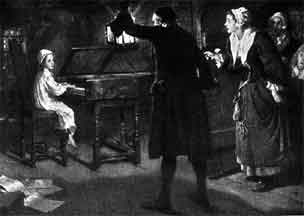Franz Joseph Hayden (1732-1809)

Joseph Haydn, a monumental figure in European classical music, shaped the symphony and string quartet genres. His prolific output includes over 100 symphonies, vocal compositions, and oratorios such as The Creation. Haydn influenced major composers like Beethoven and Mozart, leaving a lasting impact on Western classical music..
Paul Gauguin, born in Paris on June 7, 1848, was a pivotal figure in the world of art, known for his bold colors, strong lines, and distinctive style that left a lasting impact on the generations of artists that followed. Originally trained as a stockbroker, Gauguin led a conventional life, balancing his career with his growing passion for painting. However, his love for art eventually became all-consuming, leading him to abandon his secure job, and even his family, in pursuit of artistic fulfillment. This decision marked the beginning of a journey that would see him become one of the most influential figures in post-Impressionism, a movement that would pave the way for modern art.
Gauguin’s early works were heavily influenced by the Impressionists, particularly his friend Camille Pissarro, with whom he often painted. However, he quickly grew disillusioned with the Impressionist focus on naturalism and light. He sought something more profound and symbolic in his art, a desire that led him to develop his own style, which he called “synthesism.” This approach rejected the realistic depiction of subjects in favor of bold colors, flattened forms, and a focus on emotional and symbolic content. His technique was a departure from the spontaneity and lightness of Impressionism, aiming instead to convey deeper truths through more deliberate and structured compositions.
Gauguin’s dissatisfaction with modern European society was another driving force behind his art. He was deeply critical of what he saw as the materialism and moral decay of the West, and this led him to seek out places he considered more “primitive” and pure. In 1887, Gauguin traveled to Martinique, where he was captivated by the vibrant colors and exotic surroundings. This trip marked the beginning of his lifelong fascination with the tropics, and his work from this period is characterized by its vivid palette and the portrayal of local life.
However, it was in Tahiti that Gauguin found his greatest inspiration. He moved to the island in 1891, hoping to escape European civilization and immerse himself in a culture he believed was closer to nature. In Tahiti, Gauguin created some of his most famous works, characterized by their use of intense, non-naturalistic colors, strong outlines, and simplified forms. Paintings such as “Where Do We Come From? What Are We? Where Are We Going?” (1897) are not only visually striking but also filled with symbolic content, reflecting Gauguin’s spiritual and philosophical musings.
Despite his artistic success, Gauguin’s life in Tahiti was far from idyllic. He struggled with poverty, illness, and isolation, and his relationships with the local people were often strained. Nevertheless, he continued to paint prolifically, driven by his desire to create art that transcended the limitations of Western culture. His work from this period, with its vibrant colors and evocative imagery, had a profound impact on the development of modern art, influencing artists such as Pablo Picasso and Henri Matisse.
In the later years of his life, Gauguin moved to the Marquesas Islands, where he continued to paint until his death in 1903. Although he died largely unrecognized in the art world, his work gained widespread acclaim posthumously, and today, Gauguin is regarded as one of the most important figures in the history of art. His innovative use of color, his rejection of realism, and his exploration of symbolism paved the way for many of the artistic movements that followed, making him a true pioneer of modern art.
 >
>